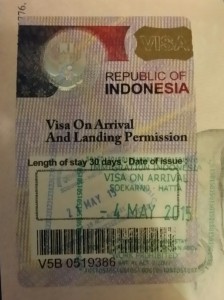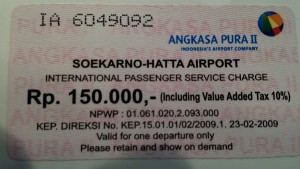International Airport in Jakarta: Arriving and Departing Posted by asimonoff on Jun 1, 2015 in Uncategorized
Most international flights to Indonesia come through Soekarno-Hatta International Airport, which is also known as Cengkareng to locals. Cengkareng is used for its international airport code “CGK.” The airport is located in Jakarta, the capital city of Indonesia. However, aside from all the advantages as a big city, Jakarta has its disadvantage, which is traffic congestion that sometimes becomes a deadlock. Therefore, careful planning on flight scheduling is important to avoid this inconvenience, especially after a lengthy flight that at least about 20 hours. When scheduling, a late arrival or an early departure will be the best.
Arriving
Upon arrival, as soon as you disembark the plane, retrieve your luggage, and if you haven’t had a visa, you go to the cashier window to pay for a Visa on Arrival (VOA) for $35.00 per passenger. The VOA will allow you to stay in Indonesia for 30 days. You can extend your visa as long as you have a ticket within the one-month extension. Fill out the forms, have a photo available, and pay another $35.00 per person for the visa extension. Be sure that you do this more than a week before the visa expires.
At the arrival area, you can find money changer booths that are open late. However, their exchange rate is quite low compared to those outside the airport. So far, “Golded Money Changer” is a money changer who can give you good exchange rates. Remember to bring with you a very pristine condition and in higher denomination (USD 100).
The next thing you do is have your VOA checked and stamped by the immigration officer.
If you haven’t had any transportation arranged for you, there will be a lot of transportation available when you are exiting the arrival gate. You can get Blue Bird Taxi, the most preferred taxi in Jakarta, or a shuttle bus to your hotel.
In case you need to go to the restroom, there is only a squatting toilette and spray water for cleaning, but no toilet paper provided. So please, keep in mind to always take with you a toilette travel pack with toilet paper, liquid soap, sanitizer and toilet covers.
Departing
There are two security checks at the airport. The first is the security check-in that will open at 04:00 am (04:00 WIB) local time, and the airline’s counters will accept check-in at 05:00 am (05:00 WIB). At this security check-in, the officer will allow you to take bottles of water inside. Take the opportunity to have your meals and to drink your bottles of water at the check-in, as there are restaurants and shops available. However, once you go through the boarding security check, you cannot take any bottles of water with you and there is no store inside.
All passengers traveling out of Soekarno-Hatta Airport will have to pay the airport tax at the airline check-in counter. For international flights, the airport tax is IDR (Rp) 150,000.00 per passenger, while the domestic flights are Rp 40,000.00 per passenger
If you need to go to the restroom, there are western style toilets available in this area. In this toilet, toilet paper and hand dryers are provided.
Related terms in English and Indonesian:
| English | Indonesian |
| Airfares/airline tickets | Tiket pesawat (terbang) |
| Airport | Bandara – Bandar udara |
| Security Check | Pemeriksaan keamanan |
| Visa on Arrival (VOA) | Visa Kunjungan (Saat Kedatangan) |
| Flight status | Status Penerbangan |
| Arrivals/Departures Schedule | Jadual Kedatangan/Keberangkatan |
| Departure lounge | Ruang tunggu keberangkatan |
| Arrivals/Departures gate | Gerbang Kedatangan/keberangkatan |
| Immigration check | Pemeriksaan keimigrasian |
| Cashier window | Loket pembayaran |
| Cash | Tunai |
| Changes | kembalian |
| Airport cashier window | Loket pembayaran bandara |
| Money changer | Tempat penukaran uang |

Build vocabulary, practice pronunciation, and more with Transparent Language Online. Available anytime, anywhere, on any device.
About the Author: asimonoff
I’m an Indonesian language instructor, instructional material developer, reading test developer, and interpreter. I have been teaching Indonesian to adult students for 15 years, and have been teaching students from many backgrounds, such as private, military and diplomatic service employees. I’m Indonesian, but am living in the US now; my exposure to different cultures in my home country and in the US has enriched my knowledge in teaching Indonesian as a second language. I approach the teaching of the Indonesian language by developing students’ critical cultural awareness and competence. This method of teaching has been proven to be a key to the success of my students. Students become conscious of the essential role culture plays in the language.





